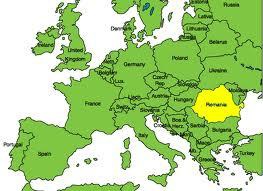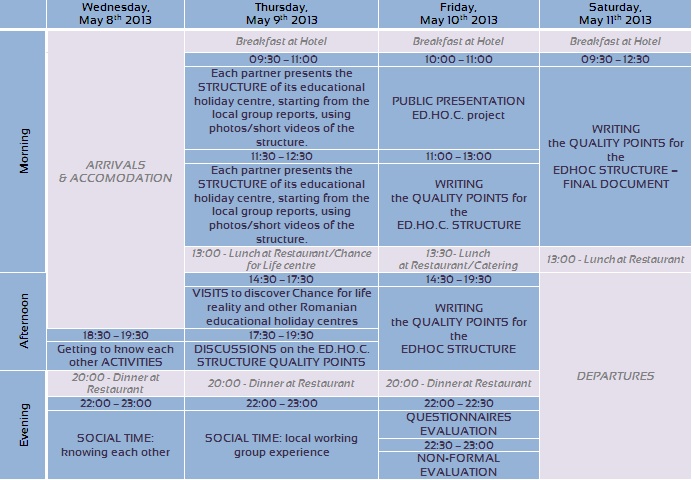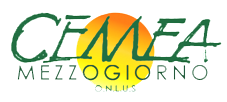Bucharest, May 8th – 11th, 2013
Study Visit Hosting Organisation
![]()
The ED.HO.C hosting organisation of the Study Visit in Romania is Chance for Life.
Chance for Life Foundation is a charity aiming to develop Romanian communities by empowering children and young people. By providing training for adults and challenging their conventional way of thinking, through social campaigns and educational, emotional and social support for children and youth, Chance for Life aims to shape the civic spirit and contribute to the sustainable development of Romanian communities.
The foundation created and follows different programs:
- “Hope for Today” is a program where Chance for Life’s specialists and volunteers work with HIV positive institutionalized young people on a daily basis, organizing various activities and projects to give them the opportunity to a have a normal development.
- “Chance for Life Scholarship” is a daily center working with 17 intellectually gifted children whose families are very poor. Some of them have been in our program for over 8 years, and the results obtained by them have proven the efficiency of the Chance for Life specialists.
- “Vodafone Scholarship Programme” focuses on providing support and guidance to 30 intellectually gifted children from Tulcea, Sulina county, who were born in families at high risk of social exclusion.
- “Tune up!”project funded by the EC, was developed to promote the establishment of a formal and stable system able to support the initiatives of organizations acting in the field of youth non-formal education within the European territories involved. The aim of the project was to define long lasting interventions able to match the different measures foreseen in the “Youth in Action” programme and capable, as a direct consequence, to give a transnational dimension to local initiatives, transversally strengthening European Citizenship.
Inside the foundation there is a staff of educators and trainers following the above mentioned programs who aim to improve their skills through long life learning programs; Chance For Life already implemented LLP projects and would like to carry on with this activities because it recognizes the importance of the continuous learning.
Study Visit Aim

The study visit will involve participants (staff members, educators, parents) from each partner organisation: CEMEA del Lazio (ITALY), Associação Juvenil de Peniche (PORTUGAL), Keric (SLOVAKIA), Telecentro de Ayerbe (SPAIN), Chance for Life (ROMANIA).
The visit offers participants the opportunity to visit the hosting organization, exchange experiences and knowledge about educational holiday centres in Europe, with a special focus on the main topic of the visit, STRUCTURE. The study visit wants to reflect, compare and contrast different elements concerning the structure where the holiday centre is placed that are functional to the educative dimension. The participants will discuss about and formulate the quality points related to the context and the logistical and structural working conditions that should be ensured for an educational holiday centre. In this way, they will write together during the visit the quality section concerning the ED.HO.C. STRUCTURE.
You can find the calendar of the mobilities and more information about the study visits’ themes at the following link: https://www.cemea.eu/edhoc-educational-holiday-centre-en/
Study Visit Participants

The Study Visit involves EDHOC participants that are involved at local level through the local working groups.
|
CEMEA del Lazio, ITALY |
Telecentro de Ayerbe, SPAIN |
|
Keric, SLOVAKIA |
Associação Juvenil de Peniche, PORTUGAL |
|
Chance for Life, ROMANIA |
Study Visit content…

During the Study Visit in Romania the participants will exchange, compare, enlarge their view on all the aspects related to the focus theme “STRUCTURE” of the educational holiday centre. On a first moment, the participants will present the structure of their educational holiday centres, starting from the reports on STRUCTURE, where each partner has summarized the reflections of its local working group on this theme.
Furtheron, the participants will explore and go deeper on the hosting organisation educational holiday centre reality in general and on the structure topic in particular, during the local visits and activities planned.
Part of the Study Visit will be dedicated to discussions and debates aimed at achieving a common agreement on which points related to STRUCTURE will be defined as quality points to be put in the final Chart. Participants will fill in together, during the visit, a common report on STRUCTURE containing the essential characteristics related to the STRUCTURE that an educational holiday center has to have to be distinguished by simple occasional leisure centers.
This document will be not only the “selection” of the best points/aspects related to the educational holiday center of each partner but there will be taken into consideration the “ideal” aspects/points that the STRUCTURE has to have.
A part from the written document (that represents the concrete result of the Study Visit), this process will give the chance to identify/give ideas about how to improve the structure of each partner’s education holiday center.
A theoretical and pedagogical discussion about what observed and focused on the main thematic assigned to the visit, will be reported to the reflection group at local level.
The programme of the SV described below is a draft proposal that may be adapted according to the groups’ needs and daily evolutions of the SV experience.
Where we will stay…


București (Bucharest) is the capital municipality, cultural, industrial, and financial centre of Romania. It is the largest city in Romania, located in the southeast of the country, lies on the banks of the Dâmbovița River.
According to preliminary data from 2011 census, 1,677,985 inhabitants live within the city limits. Adding the satellite towns around the urban area, the proposed metropolitan area of Bucharest would have a population of 2.2 million people.
The name of București has an uncertain origin: tradition connects the founding of Bucharest with the name of Bucur who was either a prince, an outlaw, a fisherman, a shepherd, or a hunter, according to different legends. In Romanian the word stem ‘bucur’ means ‘joy’ and it is believed to be of Dacian origin.

Bucharest became the capital of Romania in 1862 and is the centre of Romanian media, culture and art. Its architecture is a mix of historical (neo-classical), inter-bellum (Bauhaus and Art Deco), Communist-era and modern. In the period between the two World Wars, the city’s elegant architecture and the sophistication of its elite earned Bucharest the nickname of “Little Paris” (Micul Paris).
The city is divided into six administrative sectors. Participants shall be hosted in the 6th Sector, in Militari Area, at the Sir Hotel, a hotel close to Chance for Life’s Office (15 minutes waking). Participants will take breakfast at the hotel. Lunch and dinner will be organised at Chance for Life office and at some nice Romanian restaurants.
Arrivals & Departures
Chance for Life team will welcome the participants and accompany them by minivan to the hotel.














